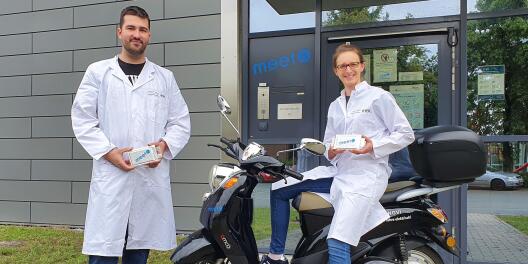“This is Where Craftsmanship Meets Technological Innovation”
The 1000sqm technical center with a dry and clean room is a piece of heart of the MEET battery research center. Here, around 170 scientists are researching batteries of the future. Yvonne Höppener and Jonathan Dylong explain the role of the technical team in MEET research and the challenges in battery cell production.
How can we imagine a typical working day for the MEET technical team?

Jonathan Dylong: “We start in a very classical way and check our emails to see which battery cells need to be built. We receive these 'orders' either MEET internally from the research divisions or externally from cooperation partners such as other universities, research institutions or from industry. Then we are off to the labs, where we spend most of our time. Our work there is highly specialized, as we assemble battery cells in about 15 coordinated steps – similar to a manufactory. This detailed workflow is needed to be able to vary each individual step and to produce a large variety of battery cells. In total, we produce about 2,000 battery cells per year on lab and test scale.”
Yvonne Höppener: “These battery cells are then used in research – either by us or by our partners. We spend most of our time in the drying room of MEET Battery Research Center. There we manufacture the battery cells in an environment that is precisely tailored to the needs of battery cell production: The 100sqm room has a maximum water-free atmosphere with a relative humidity of 0.02 per cent. A dryness even more intense than in the Sahara and with a constant temperature of 20 degrees – ideal for battery research”
What characterizes the cooperation between the technical team and the scientists in the MEET research divisions?
Yvonne Höppener: "Definitely a close exchange! In the research divisions, for example, various ideas are developed; these can comprise of a modified cell design or the use of new materials to improve the performance of a cell. We then implement these ideas practically so that the researchers can carry out further experiments with these by us designed and assembled battery cells.”
Jonathan Dylong: “Together with the colleagues from science, we are not only focusing on existing battery technologies, but also on future technologies such as the production of lithium metal batteries or the aqueous processing of cathode materials at a very early stage at MEET. At the same time, we are working on optimizing existing manufacturing processes for battery cells: Whether better mixing processes for materials, alternative techniques for coating or new cutting methods.”
What is the “fascination of battery research” for you?
Yvonne Höppener: “For me, it's the combination of curiosity and patience. For example, we are working on lithium-ion technology, which has become an established technology. Nevertheless, there is still enormous potential for further development. There are always new approaches and the technology is constantly developing. At the same time, it takes a lot of patience to validate novel ideas in view of their feasibility or to find solutions to upcoming challenges.”
Jonathan Dylong: “I am fascinated by the width of battery research. At MEET, we research along the entire value-added cycle of batteries: from raw materials ober the finished cell to recycling. We are very closely networked. And in our technical team, craftsmanship meets technological innovation – a totally appealing mixture!”

